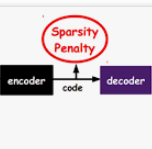In this study, the problem of computing a sparse representation of multi-dimensional visual data is considered. In general, such data e.g., hyperspectral images, color images or video data consists of signals that exhibit strong local dependencies. A new computationally efficient sparse coding optimization problem is derived by employing regularization terms that are adapted to the properties of the signals of interest. Exploiting the merits of the learnable regularization techniques, a neural network is employed to act as structure prior and reveal the underlying signal dependencies. To solve the optimization problem Deep unrolling and Deep equilibrium based algorithms are developed, forming highly interpretable and concise deep-learning-based architectures, that process the input dataset in a block-by-block fashion. Extensive simulation results, in the context of hyperspectral image denoising, are provided, which demonstrate that the proposed algorithms outperform significantly other sparse coding approaches and exhibit superior performance against recent state-of-the-art deep-learning-based denoising models. In a wider perspective, our work provides a unique bridge between a classic approach, that is the sparse representation theory, and modern representation tools that are based on deep learning modeling.
翻译:在本研究中,考虑到计算多维视觉数据少见代表的问题;一般而言,这类数据,例如超光谱图像、彩色图像或视频数据,包括显示当地依赖性很强的信号;使用适应感兴趣信号特性的正规化术语,可以产生新的计算高效稀释编码优化问题;利用可学习的规范化技术的优点,利用神经网络作为结构的先行运作,并揭示潜在的信号依赖性;为解决优化问题,开发了深平衡法,形成了高度可解释和简洁的深层次学习结构,以区块方式处理输入数据集;提供了广泛的模拟结果,在超光谱图像分解方面,这表明拟议的算法大大超越了其他稀有的编码方法,并展示了相对于最近最先进的深层学习模式的优异性表现。从更广的角度看,我们的工作在典型方法之间提供了独特的桥梁,即低频代表理论和基于深层学习的现代代表工具。</s>




